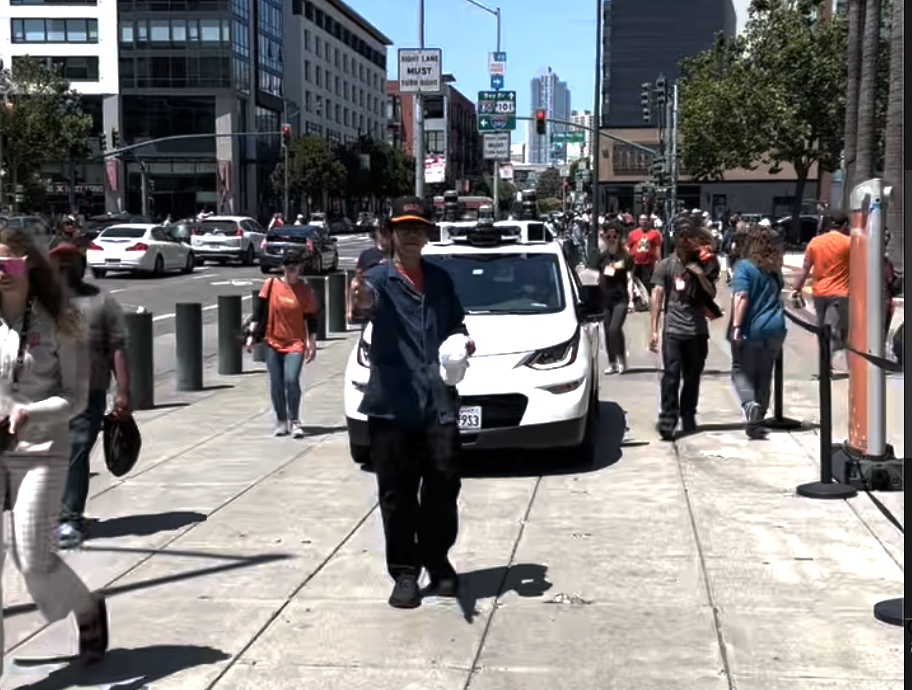Cars without drivers are now starting to flood the city. I see them everywhere, and there will be more, maybe thousands more, now that the California Public Utilities Commission has ruled that San Francisco has to allow them to operate on city streets as taxis.

A Cruise car drives on the crowded sidewalk outside Sunday’s Giants game, sending pedestrians scrambling to get out of the way. Photo by Michael Redmond
A bunch of them got caught in North Beach this weekend, blocking traffic, because, apparently, all the folks at Open Lands used up all the cell phone bandwidth, something Cruise and Waymo never planned for or figured out.
What’s happening here is a lesson for the city and the state (more on that later).
The technology allowing cars and trucks to operate without human drivers may, and probably will, get to the point eventually where it works well, at which point we will have to deal with the massive human impacts. But it seems pretty clear that the tech isn’t ready yet, and probably won’t be for at least a few more years.
And this time, unlike when Uber and Lyft and Airbnb operated illegally with the full support of the Mayor’s Office, leading to mass evictions and the destruction of the cab industry, the city is at least responding.
In fact, this latest move by the tech industry is by no means over.
At this point, the city has a lot of options, starting with an appeal to the CPUC, and possibly a lawsuit. The state Legislature can look at this: Why does a state agency get to force cities to accept robotaxis when cities in California have always had, for good reason, the authority to regulate traditional taxis?
Help us save local journalism!
Every tax-deductible donation helps us grow to cover the issues that mean the most to our community. Become a 48 Hills Hero and support the only daily progressive news source in the Bay Area.
Thanks to Sup. Aaron Peskin, there are already rules that limit the number of charging stations the autonomous vehicles can construct. That might be a modest brake.
“I am going through the Department of Motor Vehicles and the National Transportation Safety Board to take on what is really a problem of [Gov.] Gavin Newsom [who appoints the CPUC],” Peskin told me. “This is far from the end.”
By the way: The commissioner who was assigned to oversee this particular issue voted against giving Cruise and Waymo the green light; one of the commissioners who voted in favor was a former managing counsel at Cruise.
The city can levy fines on AVs that violate the law, which might not be a big deal for the huge corporations that operate these companies. The city can tow vehicles that are blocking traffic (again, that will be only a minor inconvenience for the likes of General Motors and Google).
The city already taxes so-called transportation network companies—Uber and Lyft—and that should apply to the new robotaxis. It’s also possible to add a new gross receipts tax on driverless cars, which wouldn’t bring in a lot of money right away but might reduce their profit motive and slow things down.
Slowing this down ought to be a goal; as I said, this technology is clearly not ready for prime time, and I don’t see what the people of San Francisco should suffer as the test case. (What happens when someone dies because an ambulance can’t get through North Beach because the robotaxis don’t have enough bandwidth?)
The much larger question here is how the city deals with these new fast-developing technologies. For the most part, the tech industry has always acted as if it’s better to ask for forgiveness than permission—and the city has allowed that to work.
In 2019, then-Sup Norman Yee proposed an Office of Emerging Technology to get the city ahead of the process. It passed the board—and then nothing happened.
“We attempted to get staff, and then it quieted down,” Yee told me. “The mayor was never interested, so nothing happened.”
But it’s clear the city needs something like that today more than ever. “I would love to see the current supervisors pick this up,” Yee said.



